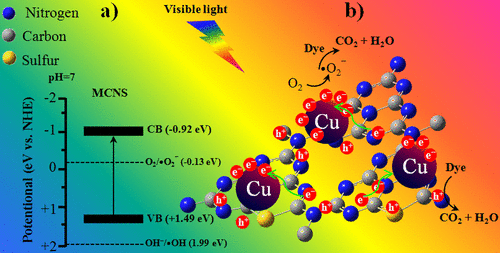当前位置:
X-MOL 学术
›
J. Phys. Chem. C
›
论文详情
Our official English website, www.x-mol.net, welcomes your
feedback! (Note: you will need to create a separate account there.)
Sulfur-Doped Mesoporous Carbon Nitride Decorated with Cu Particles for Efficient Photocatalytic Degradation under Visible-Light Irradiation
The Journal of Physical Chemistry C ( IF 3.3 ) Pub Date : 2017-08-28 00:00:00 , DOI: 10.1021/acs.jpcc.7b05556 Milad Jourshabani 1 , Zahra Shariatinia 1 , Alireza Badiei 2, 3
The Journal of Physical Chemistry C ( IF 3.3 ) Pub Date : 2017-08-28 00:00:00 , DOI: 10.1021/acs.jpcc.7b05556 Milad Jourshabani 1 , Zahra Shariatinia 1 , Alireza Badiei 2, 3
Affiliation

|
Three simultaneous strategies were successfully combined, for the first time, in one material including sulfur doping, creating a mesoporous structure, and deposition of Cu element as a low-cost non-noble metal to modify the internal and external surfaces of carbon nitride framework. For this purpose, sulfur-doped mesoporous graphitic carbon nitride (MCNS) materials were synthesized from thiourea as a low cost precursor and SiO2 gel solution as a template through a thermal condensation method. A series of copper deposited MCNS (Cu/MCNS) with Cu nominal loadings from 4 to 9 wt % were fabricated by a facile precipitation-reduction method, and the resulting samples were utilized in the photocatalytic degradation of methyl orange (MO) as a hazardous dye in aqueous solution under visible-light irradiation. Phase structures, morphologies, and textural, optical, as well as photoelectrochemical properties of Cu/MCNS photocatalysts were well characterized. Results indicated that synergistic effects of the sulfur doping, mesostructure, and especially the presence of Cu particles on the surface of MCNS extended the visible-light harvesting ability and facilitated the separation of photogenerated electron–hole pairs, and therefore, the photocatalytic activity was dramaticaly enhanced. The optimal Cu nominal loading value was determined to be 7 wt %, and the corresponding degradation rate of MO was about 100% during 90 min under the optimized operating variables conducted by the response surface methodology. In addition, the photocatalyst showed high reusability and stability without any significant decrease in its performace. Based on the trapping experiments results, the h+ and •O2¯ radicals as the predominant active species were responsible for the oxidation of MO over the Cu/MCNS catalyst under visible-light irradiation.
中文翻译:

铜粒子修饰的硫掺杂介孔氮化碳在可见光照射下的有效光催化降解
三种同时进行的策略首次成功地在一种材料中进行了组合,包括硫掺杂,形成介孔结构以及沉积铜元素作为低成本的非贵金属,以修饰氮化碳骨架的内表面和外表面。为此,由硫脲作为低成本前体和SiO 2合成了硫掺杂的介孔石墨氮化碳(MCNS)材料。通过热缩合法将凝胶溶液作为模板。通过一种简便的沉淀还原方法制备了一系列铜沉积的MCNS(Cu / MCNS),其铜的标称负载量为4至9 wt%,并将所得样品用于甲基橙(MO)的光催化降解。在可见光照射下将染料染成水溶液。Cu / MCNS光催化剂的相结构,形态,质构,光学以及光电化学性质都得到了很好的表征。结果表明,硫掺杂,介观结构,特别是MCNS表面铜颗粒的协同作用扩展了可见光的收集能力,并促进了光生电子-空穴对的分离,因此,光催化活性显着增强。确定最佳的铜标称负载值为7 wt%,并且在通过响应面方法进行的优化操作变量下,在90分钟内相应的MO降解率约为100%。另外,光催化剂显示出高的可重复使用性和稳定性,而其性能没有任何显着降低。根据诱捕实验结果,+和•Ø 2 ‾基团作为主要活性物质负责MO的在铜/ MCNS催化剂可见光照射下的氧化。
更新日期:2017-08-29
中文翻译:

铜粒子修饰的硫掺杂介孔氮化碳在可见光照射下的有效光催化降解
三种同时进行的策略首次成功地在一种材料中进行了组合,包括硫掺杂,形成介孔结构以及沉积铜元素作为低成本的非贵金属,以修饰氮化碳骨架的内表面和外表面。为此,由硫脲作为低成本前体和SiO 2合成了硫掺杂的介孔石墨氮化碳(MCNS)材料。通过热缩合法将凝胶溶液作为模板。通过一种简便的沉淀还原方法制备了一系列铜沉积的MCNS(Cu / MCNS),其铜的标称负载量为4至9 wt%,并将所得样品用于甲基橙(MO)的光催化降解。在可见光照射下将染料染成水溶液。Cu / MCNS光催化剂的相结构,形态,质构,光学以及光电化学性质都得到了很好的表征。结果表明,硫掺杂,介观结构,特别是MCNS表面铜颗粒的协同作用扩展了可见光的收集能力,并促进了光生电子-空穴对的分离,因此,光催化活性显着增强。确定最佳的铜标称负载值为7 wt%,并且在通过响应面方法进行的优化操作变量下,在90分钟内相应的MO降解率约为100%。另外,光催化剂显示出高的可重复使用性和稳定性,而其性能没有任何显着降低。根据诱捕实验结果,+和•Ø 2 ‾基团作为主要活性物质负责MO的在铜/ MCNS催化剂可见光照射下的氧化。


















































 京公网安备 11010802027423号
京公网安备 11010802027423号